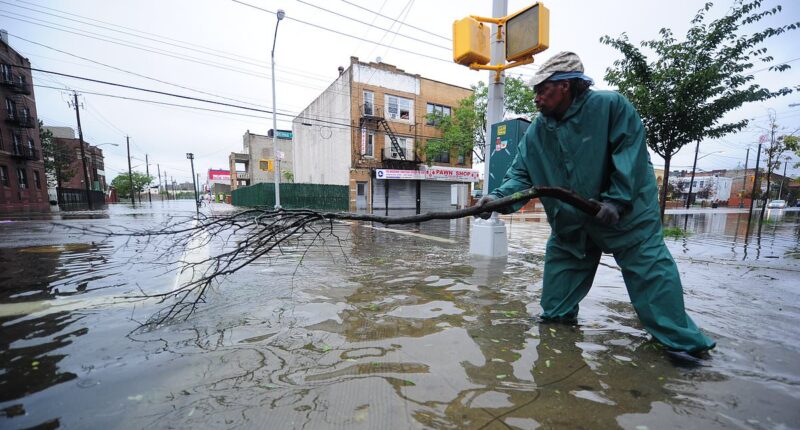Scientists have discovered that the 28 most populous cities in the US are sinking, with 34 million people living in the affected areas.
Groundwater extraction for various purposes, including drinking water, is identified as the primary reason for land sinking, although there are other contributing factors in certain locations.
A study carried out by Columbia University highlighted that although coastal cities face sinking risks, inland cities like Fort Worth and Dallas are experiencing some of the most rapid sinking rates.
Despite not being a coastal city, Houston is reported as the fastest-sinking city in the United States. Approximately half of the city is subsiding at a rate exceeding one-fifth of an inch per year, with certain areas sinking as rapidly as 2 inches annually.
Dallas and Fort Worth aren’t far behind, sinking at rates of roughly 0.16 and 0.2 inch per year, respectively.
The study also highlighted New York’s LaGuardia Airport, parts of Las Vegas, Washington DC and San Francisco as rapidly sinking zones.
The 28 cities are home to nearly tens of millions of people, and more than 60 percent if this total population lives in just eight cities: New York, Chicago, Los Angeles, Phoenix, Houston, Philadelphia, San Antonio and Dallas.
The researchers note that these cities have seen more than 90 major floods within the last 25 years, and suggest that this is due in large part to the fact that they’re sinking.
‘As cities continue to grow, we will see more cities expand into subsiding regions,’ said lead author Leonard Ohenhen, a postdoctoral researcher at the Columbia Climate School’s Lamont-Doherty Earth Observatory.
‘Over time, this subsidence can produce stresses on infrastructure that will go past their safety limit,’ he added.
Ohenhen and his colleagues used satellite data to map sinking down to the millimeter in all US cities with populations over 600,000.
They also looked at the amount of groundwater pumping in affected counties and linked it to ground sinking.
Coastal cities tend to be more prone to ground sinking due to the combined effects of groundwater pumping and sea level rise.
But multiple interior cities, such as Denver, Oklahoma City and Nashville, are experiencing moderate sinking.
Those three are sinking roughly 0.04 to 0.08 inch per year.
About one percent of land in the 28 cities is experiencing sinking that could impact critical infrastructure such as buildings, roads and rail lines.

Houston, Texas is the fastest-sinking city in the country, with over 40 percent of its area subsiding more than one fifth of an inch per year. Pictured: people walk through floodwaters in Houston during Hurricane Harvey in 2017

A 2023 study also found that the weight of buildings in densely urbanized areas may be contributing to ground sinking. New York’s more than one million buildings are pressing down on the Earth so hard that they have become an important factor in the city’s subsidence

The Palos Verdes Peninsula is sinking toward the Pacific at a rate of four inches per week
Even though that percentage seems small, these areas tend to be located in the densest parts of these cities, which contain up to 29,000 buildings.
From this perspective, the most hazardous cities are San Antonio, where one in 45 buildings are at ‘high risk’ of damage from ground sinking, Austin, Fort Worth, and Memphis.
Across the US, and in interior cities especially, ground sinking is mainly driven by groundwater pumping, the researchers concluded.
When water is extracted from aquifers made up of saturated fine-grained sediments and not replenished, the pore spaces between the sediment particles can collapse.
This causes the lower layers of the aquifer to condense and become compacted, and results in sinkage at the surface, according to the researchers.
In Texas, this is made even worse by oil and gas drilling, they explained in their report.
And there are other factors at play too.
Roughly 20,000 years ago, interior North America was covered by a towering ice sheet that made the land along its edges bulge upward.

Those researchers found that New York’s (pictured) more than one million buildings are pressing down on the Earth so hard that they have become an important factor in the city’s subsidence
That ice sheet is long gone, but some of the bulges still exist, though they are subsiding at rates of 0.04 to 0.12 inch per year.
This is adding to ground sinking observed in New York City, Indianapolis, Nashville, Philadelphia, Denver, Chicago and Portland, according to the researchers.
The team published their findings in the journal Nature Cities on Tuesday.
A 2023 study also found that the weight of buildings in densely urbanized areas may be contributing to ground sinking.
Those researchers found that New York’s more than one million buildings are pressing down on the Earth so hard that they have become an important factor in the city’s subsidence.
New construction may be playing a role too. A more recent study found that some buildings in Miami are sinking in part due to subsurface disruptions caused by buildings going up nearby.
The researchers urge cities to use their data to develop mitigation strategies for ground sinking and flood risk.
















